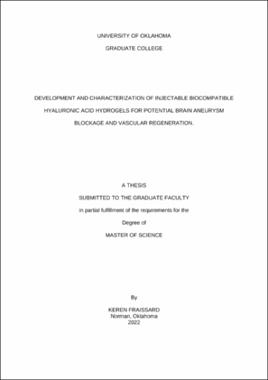| dc.description.abstract | Brain aneurysms are blood vessel wall deformations that affect 240 million people worldwide and their rupture causes the death of a fourth of the patients each year. Current brain aneurysm treatments, like surgical clips or coils, allow only partial aneurysm occlusion and partial blood vessel wall reconstruction. These treatments stay in the patient ad vitam, thus having a high risk of causing vessel wall inflammation. To address these issues, our approach is catheter-based delivery of an injectable, hyaluronic acid-based material that is compatible with radiographic and magnetic resonance medical imaging techniques. This material can be used to plug saccular brain aneurysms and induce vascular regeneration. To make our PHA hydrogels visible via brain imaging techniques to assess correct delivery and provide a control of the aneurysm degradation overtime, 50 mg/mL of tantalum powder (Ta) was incorporated to PHA hydrogels. To assess whether PHA hydrogel matches the compressive resistance of vessel walls, compressive moduli of 5, 7.5, and 10% PHA hydrogels without or with 50 mg of Ta per g of PHA were measured. The compressive moduli of 5, 7.5, and 10% PHA hydrogels without or with 50 mg of Ta per g of PHA increased with weight percent and were comprised within a 50 to 100 kPa range, which is the range of brain tissues’ compressive moduli. To verify the biocompatibility of PHA hydrogels with blood vessels, the cell viability of human umbilical vein endothelial cells (HUVEC) in contact with medium infused for 24 hours with 5, 7.5, and 10% PHA hydrogels without or with 50 mg of Ta per g of PHA was quantified. The viability of HUVEC exposed to 5, 7.5, and 10% PHA hydrogels without or with 50 mg of Ta per g of PHA was a 100%. These data point out that injectable 5 and 7.5% PHA hydrogels with compressive moduli similar to brain tissues and good viability with endothelial cells can be made to potentially plug brain aneurysms. | en_US |
